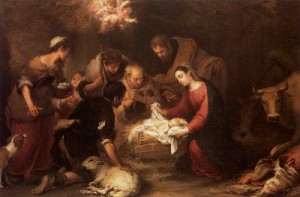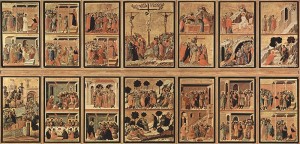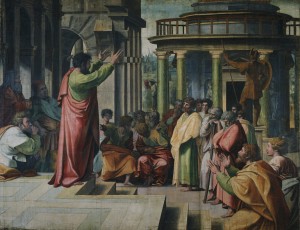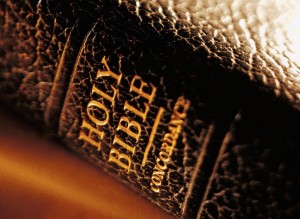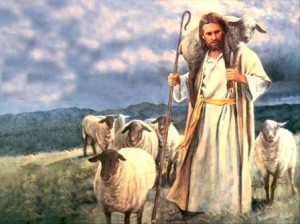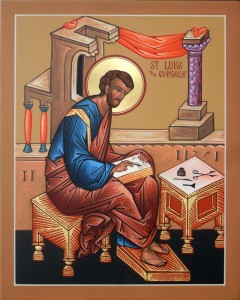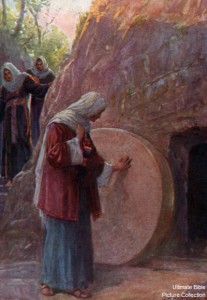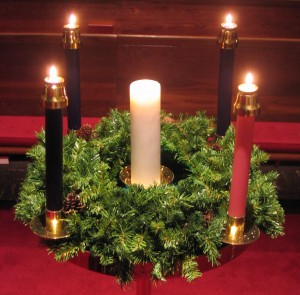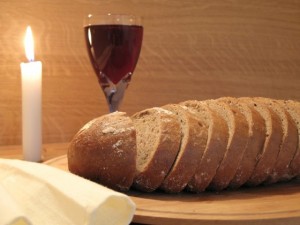Christianity
Christianity is, like Judaism and Islam, a monotheistic and Abrahamic religion. The first followers of Jesus the Christ (a man who Christians believe to be God incarnated) were Jews. Most Gentiles (non-Jews) were only taught about Jesus after his death and resurrection and his ascension into Heaven. There were a few non-Jewish believers in Jesus who met and interacted with him (the Roman centurion, for instance).
The Birth Narrative:
The birth narrative is the story of the birth of Jesus and is found in the Gospel books of Matthew and Luke, both of which are different versions. In both versions, Mary, the mother of Jesus, is told that she will have a baby (even though she is a virgin) and she will name him Jesus (or Immanuel, which means “God with us”). In Matthew, Magi (great wise-men from the East) come to visit Jesus and bring him gifts of gold, myrrh (a rare perfume), and incense. In Luke, it is shepherds who come and visit the baby, bringing their sheep and looking down on the child with awe and wonder.
Source: http://www.opusdei.ie/art.php?p=41466
The Death Narrative (a.k.a. The Passion):
After three years of ministry (according to the Gospel of John; in the other Gospels – Matthew, Mark, and Luke – Jesus’s ministry only lasts one year) Jesus goes with his disciples (followers) to Jerusalem in order to celebrate the Passover (see Judaism). Jesus and his disciples celebrated the festival, and then Jesus was betrayed by one of his followers. He was taken before the Roman government, and the Jews turned against him and sentenced him to death. They wanted Jesus crucified and one of the other prisoners released (as was the custom at the time of the Passover – the Romans would release one of the Jewish prisoners back to the people).
Jesus was thus flogged and then crucified. This event had been prophesied about in the Hebrew Scriptures. What had also been prophesied was that he would rise from the dead on the third day. Christians believe that this happened, while everyone else believes that he stayed dead.
According to believers, Jesus appeared first to his friend Mary Magdalene, who had been a harlot/prostitute before meeting Jesus, and Jesus’s mother, Mary the Virgin (she had been a virgin when she gave birth to Jesus).
Source: http://commons.wikimedia.org/wiki/File:Duccio_di_Buoninsegna_019.jpg
The Early Church period:
After Jesus ascended, his disciples started to spread the message of his teachings and who he was. They suffered at the hands of both Jews and Romans, who accused them of being ‘haters of mankind’ (for Christians would not make sacrifices to the cult of the emperor).
A man named Saul, a Pharisee (Jewish religious leader), lead numerous raids against Christians, killing many. Saul was on his way to Damascus to kill more Christians when he had a vision of Jesus. Saul never tells the audience of his letters – a major portion of the Christian Bible (the New Testament) – what his vision included, aside from the fact that it changed his life and he was given a new mission – to spread the faith to the Gentiles. This is the point in the story when Saul becomes to be known by Paul, leaving many readers to assume that he changed his name. This is not the case. Paul is what he is called when he is in the Greek speaking nations, and Saul is what he is called in Judea (the area inhabited by Jews after their return from the Babylonian exile (see Judaism)). Paul converted many Gentiles to Christianity. Peter, James, and John (disciples who walked with Jesus) stayed mostly in the Jewish areas, spreading the message (gospel – good news) there. Peter went to Rome and founded a Church there; this is why Peter is considered the first Pope – he was the first Church leader of the Church at Rome).
Source: http://www.ignitumtoday.com/2012/11/22/be-careful-about-st-paul-part-1/
Orthodox Christianity (on which the beliefs of Roman Catholics and Protestants are based) only emerged after some people were presenting doctrines that were contradictory to tradition and were causing splits in the Church. Church fathers and elders realized that without a set of firm doctrines and beliefs, the Church would continue to split apart and there would thus no longer be unity within the Church. So in a way, heretical figures are responsible for motivating orthodoxy into laying down the basics of what Christians would come to believe until the time of the Reformation under Martin Luther, an event that will not be discussed here beyond the fact that it challenged Catholicism and the idea that only the Priests, elders, and Monks should be allowed to read the Bible. The Reformation lead to the Bible being printed in multiple languages so anyone who could not read Latin, which was pretty much everyone who was not a higher up in the Church hierarchy, would have access to the Scriptures.
Religious Text(s):
-Holy Bible
- In Christianity, this includes both the Old Testament (the Hebrew Scriptures) and the New Testament (the stories of Jesus and the letters of his apostles).
Source: http://lezfemmementality.com/our-right-to-worship-homosexual-and-the-church/holy-bible
There are many apocryphal (not in the canon) texts that early Christians were reading. These texts were mostly written by heretics and so their content was deemed improper for the Bible. The texts not written by heretics do not have an identified author and those who formed the canon were unsure concerning its authorship and thus its authority.
Teachings:
-Jesus is the Savior of the world and the only way to get to Heaven is to believe in him.
-God loves all his children, even those who do not believe in him.
-When asked what the greatest commandment was, Jesus answered, “ ‘You shall love the Lord your God with all your heart, and with all your soul, and with all your mind.’ This is the greatest and first commandment. And a second is like it: ‘You shall love your neighbor as yourself’. On these two commandments hang all the law and the prophets.” Matthew 22:36-40
-Christians are to be the salt of the earth and the light of the world (this could mean preservers of mankind and leaders for how to properly live (Christians are to live as Jesus taught, but there are many today who do not live this way).
Important Figure(s):
-Jesus- Believed by Christians to be the Son of God (similar to a Hindu incarnation, but more divine than that). He is called ‘The Good Shepherd’ who takes care of his sheep (his followers).
Source: http://www.stjohnsmcc.org/new/LessonsFromStJohnStudy/07TheShepherd.php
-Paul- Wrote many letters to the different churches that existed around 50-70 A.D. The letters discussed a range of topics from spiritual gifts to sin and morality (especially of the sexual variety). His letters take up a large portion of the New Testament and are some of the only Biblical texts Christians have that discuss how to elect Bishops and leaders and how, as a human, to deal with temptation and desire. Paul struggled with these things as he sinned (Jesus did not sin, though he had been tempted by Satan – the devil – and so understood what that felt like) and so he could help instruct people in how to live with their sin and how to stay away from temptation.
-Matthew- Traditional author of the Gospel according to Matthew. His book is very Jewish-oriented. He uses Old Testament prophecies to prove that Jesus is the Messiah that the Jews had long awaited.
-Mark- (John Mark) Traditional author of the Gospel according to Mark. His gospel is the shortest of the four, as well as the most concise. It is believed that Mark traveled with Paul, and so he heard stories of Jesus’s ministry and wrote them down, though it is unsure if his writings take place in chronological order. Mark’s passion narrative (the events that lead up to and include the crucifixion and resurrection) is the longest, proportionately, of all the gospels. It also does not include Jesus meeting any of his followers after his resurrection. It simply ends with Mary Magdalene and Mary the mother of Jesus seeing the empty tomb and talking to an angel who tells them that Jesus has risen.
-Luke- (The physician) Traditional author of the Gospel according to Luke. His gospel is written to a friend (Theophilus – lover of God) and includes many stories of Jesus’s forgiveness and acceptance of all peoples. Luke is mentioned in the New Testament book of Acts as a companion of Paul. He is described as a doctor.
Source: http://holy-icons.com/2008/10/18/st-luke/
-John – (The beloved) Traditional author of the Gospel according to John. This gospel is very different from the other three. It describes who Jesus was as a divine figure and it includes stories that are not found in the other gospels. This is the gospel that most closely relates to ‘the other worldly’. It also has many statements about who Jesus was and what his purpose on earth is. John chapter 3, verse 16 (presented as 3:16) says “For God so loved the world that he gave his only son, that whosoever believes in him shall not perish, but have eternal life.” John 14:6 is a statement by Jesus: “I am the way, the truth, and the life, and no one comes to the Father except through me.” Both of these statements became creedal in the early church – a way of stating what you believe in a simple and concise way.
-Peter- One of Jesus’s disciples. During Jesus’s flogging Peter says that he does not know who Jesus is, thus fulfilling a prophecy that Jesus had said that claimed Peter would come to deny him. Peter went on to found the Roman Church and became a very important figure in early Christianity.
-James- The brother of Jesus. He was also an important leader in the early Church period. He focused on the Jewish-Christian community.
Holidays:
-Christmas- Celebrated 25 December to commemorate the virgin birth of Jesus, born in a manger in a stable. Jesus was not actually born on this day, but pagans who became Christians and had celebrated the Winter Solstice wanted to keep a part of their tradition. Christians did not know when Christ was born (except that it was cold), so they were fine with celebrating Christmas near the day of the solstice.
-Epiphany- Celebrated on or around 6 January (in Protestant churches, the Sunday between 2 and 8 January). This commemorated the visit of the Magi to Jesus (in Western traditions) and the day on which Jesus was baptized in the Jordan River (in Eastern traditions).
-Lent-The 40 days of fasting that takes place between Ash Wednesday and Easter Sunday. It commemorates the 40 days that Jesus spent wandering in the desert after his baptism and before his temptation by Satan. In Western traditions Christians give something up that takes their focus away from God (Facebook, certain foods (though that might be just to have a healthier diet for a while), reading, or anything like that).
-Palm Sunday- Takes place the Sunday before Easter. This commemorates Jesus’s entrance into Jerusalem when he was praised by the Jewish people.
-Good Friday- Takes place on the Friday before Easter. Commemorates the day on which Jesus was crucified. It is called ‘good’ because Jesus died so that humans might be able to enter Heaven after death even though they had lived a life of sin.
-Easter- Celebrates Christ’s return from the dead and the empty tomb where his body had been laid. This also marks the end of the Lent season.
Source:http://bibleencyclopedia.com/pictures/John_20_Mary_finds_Jesus’_empty_tomb.htm
-Pentecost- Takes place 50 days after Easter. It commemorates the day on which the Holy Spirit came down from Heaven and blessed them in their mission to go out into the world and spread the good news of Christ. Pentecost can also refer to the whole 50 days between Easter and Pentecost.
-Advent- The season leading up to Christmas that in most Western traditions begins on the fourth Sunday before Christmas. It is a season of waiting for the birth of Christ. Many families have an Advent wreath, which holds 5 candles (4 placed in a square around a center candle), and light one candle on each Sunday and the 5th candle on Christmas day.
Source: http://www.gointl.org/english/?p=415
Vocabulary:
-Canon- Set of texts that have been approved by the Early Church to hold proper doctrine and authority.
-Messiah/Christ- (same word in two different languages) ‘The anointed one’. It is believed that Jesus became the Messiah/Christ when a dove came down from Heaven and the voice of God claimed Jesus to be his (God’s) son.
-Gospel – The Greek word for ‘good news’.
-Orthodoxy- Set of traditions that go back to the beginning of the early Church. Some orthodox take the Scriptures literally, others metaphorically; it all depends on the individual believer. Orthodox is sort of synonymous with ‘tradition’. Anyone who wants to can read the Bible, but not all can participate in the sacraments if they are not Orthodox.
-Catholicism- Refers to those who ascribe to the tradition set down by Peter and those who followed him and his teachings. It is a more traditional viewing of Scriptures than Protestants, but not as strict as some Orthodox. Today, Catholics can read the Bible if they want to; there are no restrictions toward gender, age, or understanding of the Scriptures. But only males can become Bishops, Cardinals, and Popes.
-Protestantism- This results from Martin Luther’s reformation. Protestants hold to the idea that anyone who wants to can read the Bible and teach it to others, even if they have not been fully educated in all of the scriptures. All can participate in the sacraments, as long as they accept Jesus as their Lord and savior.
-Sacraments- Holy actions that take place in the Church:
- Baptism- A person who confesses Jesus as the Christ gets water put on their head and the Priest/Pastor/Church leader claims that person as a Christian.
- Communion- Commemorates Jesus’s celebration of Passover when he took the bread, broke it, and passed it to his disciples saying “Take. Eat. This is my body broken for you. (Every time you eat) do this in remembrance of me.” Then he took the wine goblet (which was not supposed to be touched by Jews until the Messiah had come), and gave it to his disciples saying, “Take. Drink. This is my blood poured out for you. (Every time you drink) do this in remembrance of me.”
Source: http://truthfellowshiplive.com/blog/the-importance-of-communion/
- Confirmation- A person who wants to be recognized as a Christian by the Church takes a class in which he/she learns a lot about Christ, his teachings, and the early Church, and then stands in front of the congregation (the gathered church community) and accepts Jesus. This usually occurs during a child’s middle school years, but there are classes for adults to take that are separate from the children’s.

